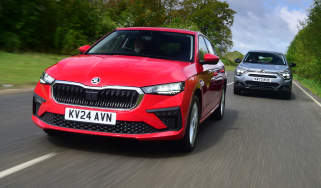New Volvo EX90 ride review: luxury EV shows plenty of promise
We go for a passenger ride in the new all-electric Volvo EX90 SUV
The Volvo EX90 will have a tough job on its hands when it arrives later this year. The pure-electric seven-seat flagship SUV won’t just look to (eventually) replace the popular Volvo XC90, it’ll also act as the champion of the brand’s assault on the electric era.
With so much at stake, we popped over to Volvo’s proving grounds near Gothenburg, Sweden, for a rundown on the new model from its creators, and to gather some initial impressions from the passenger seat.
The EX90’s design and packaging aren’t a million miles from the XC90’s – and the older car with its hybrid powertrains will still be sold alongside the electric car for now – but the new car sits on a brand-new electric-vehicle platform called SPA2, which fundamentally changes the game under the skin.
There will be two powertrain options at launch. Both have dual motors; the base car gets 402bhp, while the Performance derivative packs 509bhp. They share an 111kWh battery pack (107kWh usable), which is underpinned by a 400V electrical system that will charge at up to 250kW, giving a 10-80 per cent top-up in around 30 minutes. The base version has a range of up to 364 miles, with the Performance model only a few miles behind.
But we already know many of these facts and figures. Instead, we’re here to feel how the new car is going to ride and perform before we get behind the wheel ourselves later this year. First impressions show a clear emphasis on comfort and refinement, with our particular test car in a specification that’s expected to be popular in the UK. This includes the dual-chamber air suspension and middle 21-inch wheel option, both of which buffed away the edges of Volvo’s punishing test route.
Our driver for the day is Kenneth Ekstrom, principal engineer of vehicle dynamics, who explains: “Our cars must be predictable and safe; these are the most important attributes. Our air-suspension system has been designed with these two thoughts in mind from the very start.” There’s no way of getting around the fact this is a big, heavy car (2,750kg), so keeping that mass under control was crucial for Ekstrom’s team.
“The steering is very important, so we have focused on steering feel just from the straight ahead, making it more accurate and controlled. The torque-vectoring differential is also important for this, because it helps keep the car stable at high speed.” That unit is the same as on the forthcoming Polestar 3, but there it’s designed to boost the power delivery at the rear axle. Here, it’s meant only to improve stability.
Weaving through some of the high- speed sections, the EX90 feels stable and controlled. While there is some roll and pitch, it’s never unstable or floaty, even as the tarmac drops from beneath us on more aggressive undulations. This isn’t really something you could say of the most recent XC90, which many owners felt was bigger and heavier than it was. We do have some reservations over ride quality on the largest 22-inch wheels in the UK, but this is hypothetical until we’ve tried them out.
While the exterior design is very slick, we can’t help feeling that perhaps it isn’t the leap forward that it could have been. Despite being all new, the body looks very similar to the XC90’s – only a touch more angular and with use of gloss black at the sills to hide the extra height of its body due to the under-floor battery pack. But so popular has the current XC90 been that a little design restraint will be neither surprising nor unwelcome to customers.
Space inside is good, and the high floor hasn’t affected packaging in the third row. In the middle row, the floor is completely flat. Project lead Hande Ergiturk told us EX90 customers don’t want to compromise on the luxury or versatility they’ve long enjoyed in their old XC90s.
It’s worth noting the cabin ambience and user interfaces, because these will define the car for customers just as much as its high-speed cornering attitude. Volvo has had a firm grasp on its idea of modern luxury for decades, and things are no different with the new EX90, thanks to a combination of open-pore woods, plush fabrics and a general sense of quality.
Of course, you’ll be expecting as much, considering the new EX90 will cost from £96,255 when it arrives in showrooms later this year. This makes its price nearly £20,000 more than a like-for-like Kia EV9.
Whether the EX90 will be worth the extra remains to be seen, but Volvo’s pricing didn’t put buyers off when it last renewed its seven-seater flagship.






